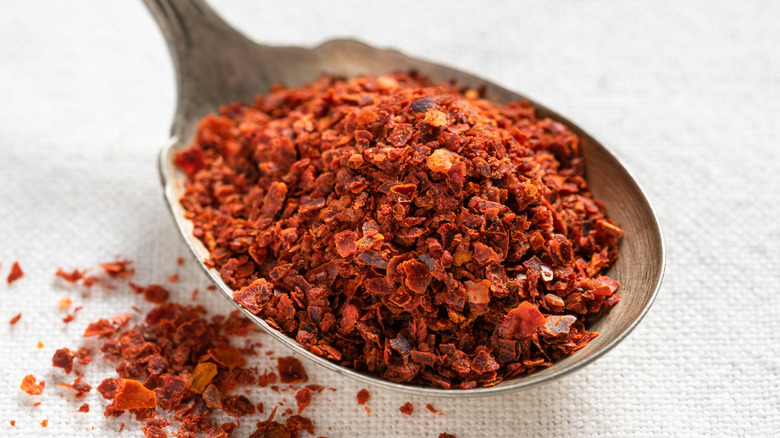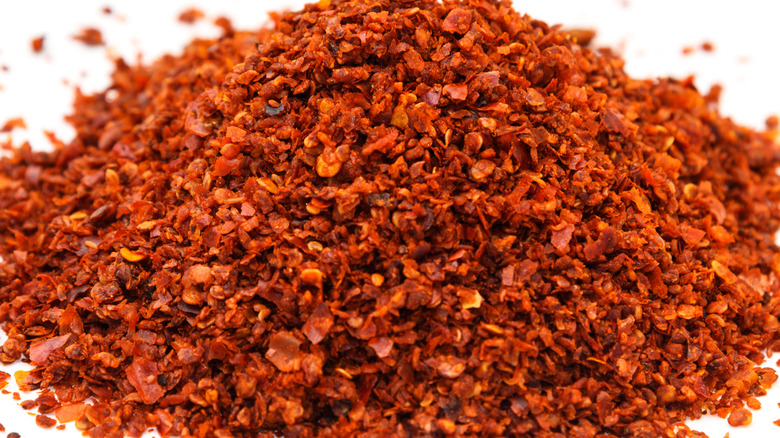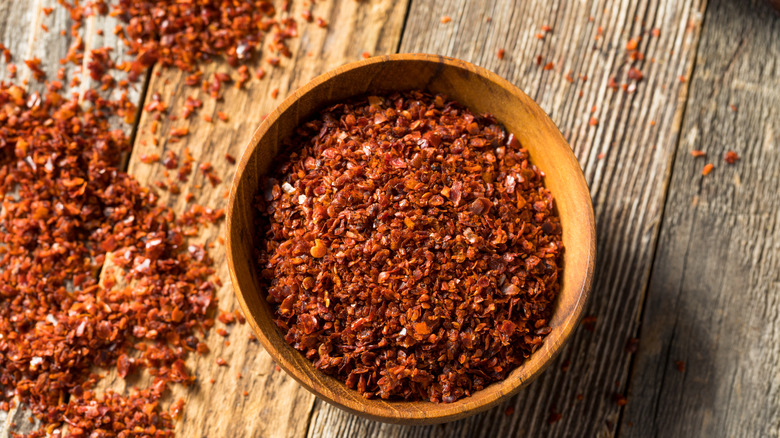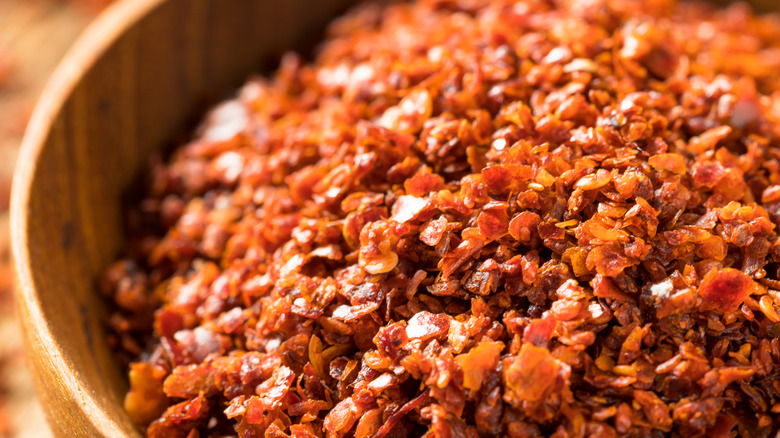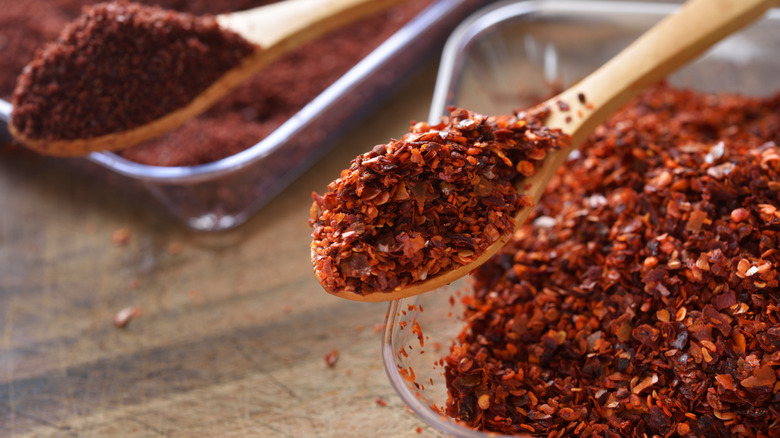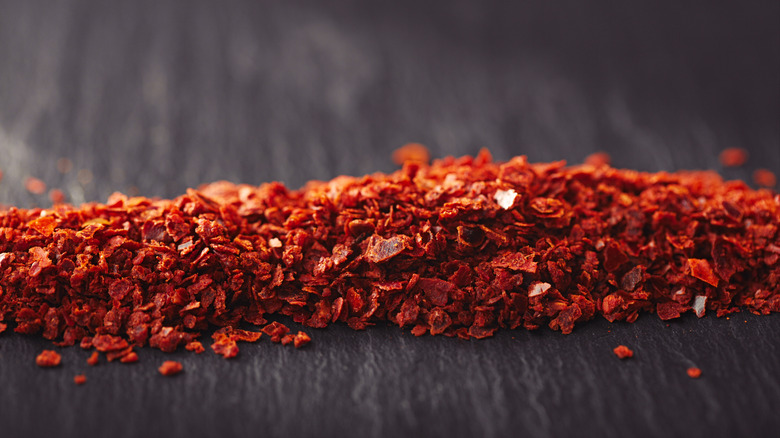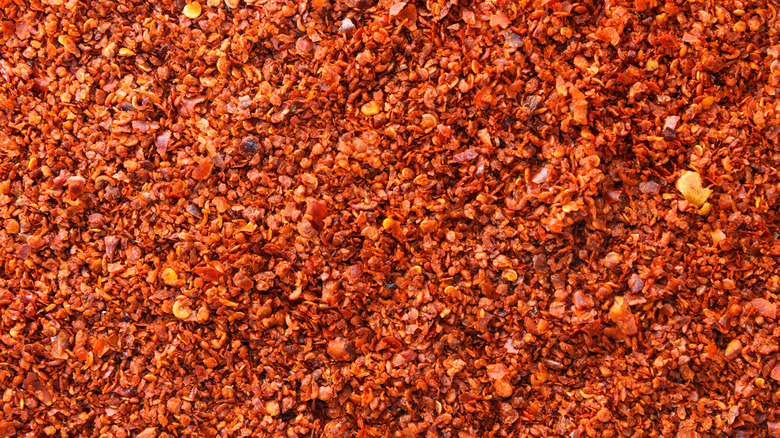What Is Aleppo Pepper And What Does It Taste Like?
When you need to add a spicy kick to your favorite meals, nothing does the trick like some crushed, spicy pepper flakes. Yet, while this add-on can elevate any meal it touches, trying to find the right kind of pepper flakes for your cuisine can prove more challenging than you might expect. According to Bon Appétit, the common, crushed red pepper flakes you see in a glass jar at your favorite pizza joint consist of jalapeño, bell, Fresno, and Anaheim peppers, while cayenne pepper makes up the spice found at most major grocery stores. If you want a singular spice with much more character, you need to aim for chile flakes, a singular-type of crushed pepper made from specific species of peppers that contain all the flavor nuances you expect in the ingredient.
For this reason, crushed chipotle flakes take on the signature smoky notes that their namesake pepper conjures up, and differ considerably from other flakes, like urfa biber pepper flakes. When you want a flake filled with a flavor like no other that delivers a mild spice note to your meals, take the plunge and invest in a small jar of crushed Aleppo pepper to take your cooking to the next level.
What is Aleppo pepper?
Aleppo peppers have a unique flavor and heat profile thanks to their origin. Like the name suggests, the plant derives from the Middle East and takes its name after the Syrian city of Aleppo (via Leite's Culinaria). While Turkey now produces the majority of these peppers, The New York Times explains that Syria once dominated production of the spice. However, due to the ongoing civil war, Syria's agriculture sector collapsed and the brunt of production fell on nations with similar climates to grow the plant. While Caucasian dishes and near-East feasts rely on this spice, the pepper has yet to make its mark on most Western recipes.
Aleppo peppers, also called Halaby pepper, feature a burgundy color as they ripen and get semi-dried before further processing occurs. However, finding whole, unprocessed Aleppo peppers stateside can prove tricky, as they get ground to flakes before they arrive in the country. Fresh flakes should maintain the signature burgundy color, have a detectable amount of oil on the flakes, and should smell fruity, similar to the finish of sun-dried tomatoes. These qualities develop thanks to the processing that the Aleppo peppers have to undergo before shipping out to grocers.
How is Aleppo pepper made?
If you find Aleppo peppers in your area, you should take a moment to appreciate how they made their way from their origin to your area after going through an intense preparation process. According to Leite's Culinaria, this particular pepper must get dried, deseeded, and either crushed or ground before getting packaged and shipped out for sale. This sounds straightforward, but ends up taking long stretches of time to do properly.
According to The New York Times, the freshly harvested crop of peppers gets cleaned with pieces of white cloth instead of getting washed with water. After cleaning, workers cut each pepper lengthwise on one side only, remove the seeds, and let the peppers dry in the sun out on rooftops. Once the produce partially dries, the peppers are ground with a bit of salt and olive oil, and then continue to dry on the roofs. Large companies responsible for selling the spice rely on several thousand families for the labor. This small-scale affair makes each batch of Aleppo pepper extremely unique and special.
What does Aleppo pepper taste like?
Aleppo pepper's unique preparation allows the chile flakes to take on a flavor like nothing else. It falls on the milder end of pepper flakes, perfect for anyone looking to add flavor over spice in a dish. The sweetness and heat compare to Ancho chiles, while taking on notes of cumin, vinegar, fruitiness, and a hint of salt. For heat reference, it ranks about half as spicy as the red pepper flakes you find at your typical pizzeria. The earthiness of the spice easily boosts any food you pair it with, and can easily enhance any flavor.
Thanks to the lack of heat and sweet, subtle flavors wrapped up in the spice, Aleppo pepper makes a better condiment than an auxiliary spice. For a unique spice with a signature flavor like no other, you have to taste this pepper just once for the flavor to stick with you for the rest of your days.
How to cook with Aleppo pepper
Thanks to the pepper's complex flavor profile, you can add Aleppo pepper to any dish you want to add an extra dimension to. You can use the spice in its raw or cooked form, and many love to add the pepper to foods you would typically top with red pepper flakes. Potential meals that benefit from Aleppo peppers range from pastas, pizzas, and salads, in addition to complimenting a variety of yogurt dips and cheeses.
Additionally, you can add the pepper to oils to make marinades for meat, coat roasted vegetables, and even rim cocktail glasses with the pepper for a sweet, earthy finish on your favorite beverage. Since you can only find the pepper in its ground form, you don't have to worry about any errant seeds entering your meal and can help finish off anything that needs a bit of a flavor punch.
This versatile spice can even take your everyday lunch to the next level; Aleppo peppers do wonders when added to eggs, and even go great on pimiento cheese sandwiches, adding a bite similar to sun-dried tomatoes. Don't forget about using the pepper in desserts, too. By pairing Aleppo peppers with chocolate, you bring out hidden flavor notes hiding in your go-to sweet.
Where to buy Aleppo pepper
Trying to find this one-of-a-kind spice proves trickier now than ever before. According to the Los Angles Times, the civil war in Syria completely disrupted the production of Aleppo pepper and, while Turkey has picked up the slack, global grocers still face shortages of the products. U.S. producers recognized the production issues and started growing the species of pepper domestically for sale as well (via The New York Times). Due to the change in supply chain, you have the best luck ordering the spice online or getting it in person at your local Middle East grocer. Just make sure that the pepper flakes come labelled as "Aleppo" or "Aleppo-style." Otherwise you might have accidentally just bought Urfa Biber, an entirely different type of pepper flakes.
If you get super lucky, you might find the spice at a higher-end grocery store. Aleppo peppers also sometimes go under the name pul biber or haleb biber. When in doubt, feel free to ask the store's clerks for clarification if you end up buying the spice in person. If you just can't find Aleppo peppers, you can whip up your own pepper blend to mimic the spice; you can mix Hungarian sweet paprika with a pinch of cayenne to create an approximation. This mix can't truly measure up to the Aleppo pepper's unique flavor profile, but it can suffice in a pinch.
Nutritional information about Aleppo pepper
If you want a healthy add-in, you need to include some Aleppo pepper into your next meal. According to Natural Food Series, Aleppo pepper contains a negligible amount of calories and sodium, while packing in a variety of useful vitamins and minerals like calcium, iron, potassium, vitamin A, folic acid, and vitamin C. The inclusion of vitamin C can boost your immune system, while the vitamin A content found in the spice has the potential to better your eyesight. The pepper can help anyone looking to better their cardiovascular health, improves metabolism, and reduces inflammation.
The overall amount of health benefits that derive from consuming Aleppo pepper makes adding this spice into your meals a no brainer. After one taste, you will never want to eat another form of flaked pepper ever again. Once you start seeing the health benefits that come with the unique spice, too, you will want to include this pepper in every recipe.
